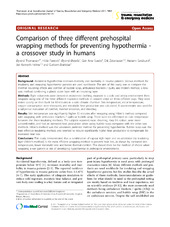| dc.contributor.author | Thomassen, Øyvind | en_US |
| dc.contributor.author | Færevik, Hilde | en_US |
| dc.contributor.author | Østerås, Øyvind | en_US |
| dc.contributor.author | Sunde, Geir Arne | en_US |
| dc.contributor.author | Zakariassen, Erik | en_US |
| dc.contributor.author | Sandsund, Mariann | en_US |
| dc.contributor.author | Heltne, Jon-Kenneth | en_US |
| dc.contributor.author | Brattebø, Guttorm | en_US |
| dc.date.accessioned | 2012-01-25T15:06:26Z | |
| dc.date.available | 2012-01-25T15:06:26Z | |
| dc.date.issued | 2011-06-23 | eng |
| dc.Published | Scandinavian Journal of Trauma, Resuscitation and Emergency Medicine 2011, 19:41 | en |
| dc.identifier.issn | 1757-7241 | |
| dc.identifier.uri | https://hdl.handle.net/1956/5523 | |
| dc.description.abstract | Background: Accidental hypothermia increases mortality and morbidity in trauma patients. Various methods for insulating and wrapping hypothermic patients are used worldwide. The aim of this study was to compare the thermal insulating effects and comfort of bubble wrap, ambulance blankets / quilts, and Hibler’s method, a lowcost method combining a plastic outer layer with an insulating layer. Methods: Eight volunteers were dressed in moistened clothing, exposed to a cold and windy environment then wrapped using one of the three different insulation methods in random order on three different days. They were rested quietly on their back for 60 minutes in a cold climatic chamber. Skin temperature, rectal temperature, oxygen consumption were measured, and metabolic heat production was calculated. A questionnaire was used for a subjective evaluation of comfort, thermal sensation, and shivering. Results: Skin temperature was significantly higher 15 minutes after wrapping using Hibler’s method compared with wrapping with ambulance blankets / quilts or bubble wrap. There were no differences in core temperature between the three insulating methods. The subjects reported more shivering, they felt colder, were more uncomfortable, and had an increased heat production when using bubble wrap compared with the other two methods. Hibler’s method was the volunteers preferred method for preventing hypothermia. Bubble wrap was the least effective insulating method, and seemed to require significantly higher heat production to compensate for increased heat loss. Conclusions: This study demonstrated that a combination of vapour tight layer and an additional dry insulating layer (Hibler’s method) is the most efficient wrapping method to prevent heat loss, as shown by increased skin temperatures, lower metabolic rate and better thermal comfort. This should then be the method of choice when wrapping a wet patient at risk of developing hypothermia in prehospital environments. | en_US |
| dc.language.iso | eng | eng |
| dc.publisher | BioMed Central | eng |
| dc.rights | Attribution CC BY | eng |
| dc.rights.uri | http://creativecommons.org/licenses/by/2.0/ | eng |
| dc.title | Comparison of three different prehospital wrapping methods for preventing hypothermia - a crossover study in humans | en_US |
| dc.type | Peer reviewed | |
| dc.type | Journal article | |
| dc.description.version | publishedVersion | en_US |
| dc.rights.holder | Copyright 2011 Thomassen et al; licensee BioMed Central Ltd. | |
| dc.identifier.doi | https://doi.org/10.1186/1757-7241-19-41 | |
| dc.identifier.cristin | 848247 | |
| dc.subject.nsi | VDP::Medical disciplines: 700::Clinical medical disciplines: 750 | eng |
| dc.subject.nsi | VDP::Medical disciplines: 700::Health sciences: 800::Health service and health administration research: 806 | eng |

